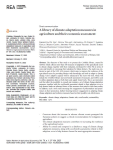De Leo S., Villani G., Di Fonzo A., Giuca S., Gaito M., Volta A., Vecchi A., Tomei F., Pratizzoli W., Bonati G. (2023). A library of climate adaptation measures in agriculture and their economic assessment. REA. Rivista di economia agraria, 26/09/2023, vol. 78, n. 1, p. 97-104.
https://doi.org/10.36253/rea-13995
https://doi.org/10.36253/rea-13995
| Titre : | A library of climate adaptation measures in agriculture and their economic assessment (2023) |
| Auteurs : | S. De Leo ; G. Villani ; A. Di Fonzo ; S. Giuca ; M. Gaito ; A. Volta ; A. Vecchi ; F. Tomei ; W. Pratizzoli ; G. Bonati |
| Type de document : | Article |
| Dans : | REA. Rivista di economia agraria (vol. 78, n. 1, September 2023) |
| Article en page(s) : | p. 97-104 |
| Langues : | Anglais |
| Langues du résumé : | Anglais |
| Catégories : |
Catégories principales 07 - ENVIRONNEMENT ; 7.6 - Changement ClimatiqueThésaurus IAMM CHANGEMENT CLIMATIQUE ; AGRICULTURE ; ADAPTATION AU CHANGEMENT ; METHODE ; MESURE ; EVALUATION ECONOMIQUE ; ANALYSE COUT AVANTAGE ; ITALIE |
| Résumé : | The objective of this study is to present the CAMBIA library, created by ARPAE, which collects more than 100 measures of adaptation of the agricultural sector to climate change, together with their evaluation, developed by CREA PB, in terms of costs and benefits to encourage their adoption by Italian farmers. The study was conducted as part of the LIFE ADA project, which aims to improve the resilience of the agricultural sector by providing farmers with knowledge and tools to adapt to climate change. Users' adaptive capacity will be enhanced by the ADA web tool, which will include the CAMBIA library and cost-benefit assessment of measures, and will be used to define adaptation plans at both farm and supply chain levels. This is an innovative tool that offers the possibility to consult and compare a set of climate change adaptation measures, together with the cost/benefit assessment related to their adoption so as to help farmers make an informed choice of the measures best suited to their farm reality. In addition, such a tool could encourage the engagement of policymakers and practitioners in their promotion, further fostering farmers' engagement in adopting climate change adaptation and resilience measures based on their possible cost-effectiveness. |
| Cote : | En ligne |
| URL / DOI : | https://doi.org/10.36253/rea-13995 |







